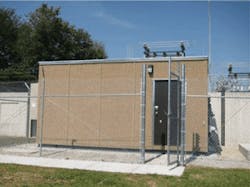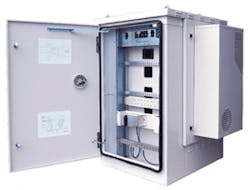Fiber Hut Considerations for Municipal Broadband
Municipal broadband offers members of a community important and distinct benefits when compared with incumbent providers. Unlike traditional broadband providers that restrict network deployment only to the areas that demonstrate a high return on investment, the municipal control and decision making can ensure that the fiber network is made universally accessible to all members of the community. Municipalities want the flexibility to be creative and the ability to innovate as necessary to meet the needs of the community. Municipal decision making provides the opportunity to expand, change business models, and grow with the community.
Figure 1. Fiber Hut
As the demand for broadband data continues to grow exponentially, the importance of improved network design and layout, as well as the construction of the physical plant and fiber backbone to provide those services, continues to challenge the industry. Driving these challenges is the need to accomplish the network design and build in the most cost-effective manner while maximizing the revenue potential once the networks have been deployed and are operational.
Basic Network Design
As municipalities consider different options for constructing a fiber distribution network, the Fiber Hut and the Fiber Active Cabinet have emerged as common network design elements for many cities. Here’s why.
Municipalities generally do not have Central Offices (COs) (Telcos) or Head-Ends (MSOs) like other incumbent providers where all of the circuits get aggregated. You can easily spot these incumbent COs in just about any city. They are the sturdy buildings typically with no windows where all of the telephone lines or video cables (and fiber) come into a common place. When municipalities decide to deploy high-speed broadband to their residents, they first have to create places to put the communications equipment, racks, power, A/C, and fiber terminations.
If the municipality is small enough, perhaps they could dedicate space in a city office. But this is not always a logical choice. Small municipalities could homerun all fiber connections from every resident back to a central location (like the CO concept) where the electronics are ready for service. But, this may be impractical. Therefore, a driving force for the idea of a Fiber Hut and a Fiber Active Cabinet as part of a distributed network is the desire for a location with enough space for placing the necessary electronics and fiber closer to customer. The Fiber Hut and Fiber Active Cabinet are great solutions for many municipalities looking to roll out fiber.
Figure 2. Fiber Active Cabinet
As with any network build, the distinct physical layout of the wire center dictates the associated costs for construction. For example, it is unlikely to find any 2 streets alike. Outside plant engineering regularly deals with different configurations of fiber optic cables, utility pole attachments, underground vaults, and communications conduits. In addition, the variations in soil conditions and presence of rocky soil, silt, sand, and clay, all contribute to network costs. Further, the condition of utility poles for possible aerial construction across bridges, railways, and highways, all affect costs.
Trade-Offs on Network Design
The Fiber Hut and Fiber Active Cabinet perform similar functions but on a different scale. They both provide secure locations — both logically and physically. They both provide access to reliable power and in the case of the Fiber Hut, there may also be a diesel generator for emergency power backup. Finally, they both provide a way to terminate all of the fiber optic lines so that connections can be made between the customers and the network equipment.
InvisiLight® Solution for Deploying Fiber
April 2, 2022Go to Market Faster. Speed up Network Deployment
April 2, 2022Episode 10: Fiber Optic Closure Specs Explained…
April 1, 2022Food for Thought from Our 2022 ICT Visionaries
April 1, 2022For municipal broadband, plopping down a Fiber Hut and putting it in a location that optimizes the serving area makes a lot of sense. We see many localities place the Fiber Hut near municipally owned property such as a community pool or ballfield where they have the right-of-way to bring fiber to it. Municipalities that put the Fiber Hut on public property minimize the hassle of deploying truck rolls into a neighborhood. Nobody wants to see a bunch of bucket trucks parked out in front of their neighborhood. Essentially, these locations provide a way to access the fiber optic rings and provide a "mini-CO" for the serving area.
Fiber networks are typically divided into 2 areas: a distribution network, and an access network. The distribution network is the portion that connects the central location (or in this case the Fiber Hut) to the Fiber Active Cabinet.
From an architecture perspective, there are generally 2 paths for utilizing these distribution and access networks.
1. Consolidate all of the electronics for the distribution network (fiber rings) along with all the electronics for the access network (equipped with Optical Line Terminals or OLTs) in one location: the Fiber Hut. Use only passive equipment (fibers and splitters) in the access network; or
2. Place only the electronics for the distribution network in the Fiber Hut and run fiber out to a Fiber Active Cabinet that contains both access network equipment (OLTs) as well as passive equipment (fibers and splitters).
Like this Article?
Subscribe to ISE magazine and start receiving your FREE monthly copy today!
In the first case, placing all of the electronics in the Fiber Hut allows consolidation of power sources. This architecture avoids the requirement for power in the access network since only passive equipment (splitters and fiber) is being used in the access network. Selecting this type of architecture may increase the costs of the Fiber Hut but reduce access costs by placing only passive cabinets like Fiber Distribution Hubs (FDHs) in the field. A downside of this approach is that it may limit the network reliability of redundancy from the Fiber Hut out to the FDH.
In the second case, pushing the electronics out in the field to be part of the Fiber Active Cabinet allows network redundancy by using ring technology to connect access networks to the Fiber Hut. This architecture intentionally uses multiple Fiber Active Cabinets in the wire center all connected on fiber optic rings back to the Fiber Hut. The redundancy of the fiber rings allows customers served from one cabinet to remain in service if an outage occurs at another cabinet on the ring. In this way, subscribers maintain connection (through the ring) back to the Fiber Hut. Choosing this architecture can be advantageous because it reduces the size (and costs) of the Fiber Huts. Clearfield® produces a variety of Fiber Active Cabinets that fit this purpose.
Figure 3. Fiber Passive Cabinet
Selecting a model that accommodates both designs allows the municipality to have flexibility in growing the network. It may make sense to start with a Fiber Hut and progress to add Fiber Active Cabinets, placing more electronics out in the field closer to the customer. That allows the municipality to "go as you grow" into the community.
A passive cabinet requires strict adherence to the basic rules of fiber management along with a termination process that satisfies the standards. Access, bend radius protection, physical fiber protection, and route diversity, must be present, along with a high-quality termination certified to the Telcordia standards, for passive network elements in a FTTH network to ensure the reliability and performance of the network.
Conclusion
Current and future broadband technologies require that active equipment be placed deeper in the network. These same technologies require that fiber be placed right there alongside them to quickly transport and backhaul content with the lowest latency possible. The insatiable demand for bandwidth requires these 2 network elements (active/passive) come together. Fiber must be placed as close to the actives as possible to quickly facilitate all this traffic.
Municipal Broadband service providers have used a hybrid approach with combinations of Fiber Huts to start in the distribution network, adding Fiber Active Cabinets as they grow, and placing Passive Cabinets from the start in the access portion of the network edge closer to subscribers. When it comes to outside plant network design, there is no one-size-fits-all. Being open to use all 3 structures provides the most flexibility in the long run.
About the Author

Kevin Morgan
Chief Marketing Officer, Clearfield
Kevin Morgan is Chief Marketing Officer at Clearfield, joining the company in August 2016. Morgan has served in various senior marketing positions since 1996 at ADTRAN, Inc. where he gained extensive experience in advanced communications technology, fiber optic systems, and business product marketing. Before that, he spent nearly a decade at telephone operating company BellSouth, now a part of AT&T, where he worked as a network engineer and the lead product evaluations resource of broadband technologies in the Science & Technology department. Morgan also served in various industry leadership positions at the Fiber Broadband Association, including three times as the association’s Chairman of the Board of Directors in 2015, 2019 and 2022, after first being elected to the Board in 2010. Mr. Morgan received a B.S. in Electrical Engineering from Auburn University and an MBA from the University of Alabama. For more information, please email [email protected] or visit www.SeeClearfield.com.







